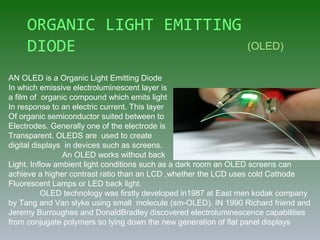
Everything You Need to Know About OLED Displays
- 1. ORGANIC LIGHT EMITTING DIODE AN OLED is a Organic Light Emitting Diode In which emissive electroluminescent layer is a film of organic compound which emits light In response to an electric current. This layer Of organic semiconductor suited between to Electrodes. Generally one of the electrode is Transparent. OLEDS are used to create digital displays in devices such as screens. An OLED works without back Light. Inflow ambient light conditions such as a dark room an OLED screens can achieve a higher contrast ratio than an LCD ,whether the LCD uses cold Cathode Fluorescent Lamps or LED back light. OLED technology was firstly developed in1987 at East men kodak company by Tang and Van slyke using small molecule (sm-OLED). IN 1990 Richard friend and Jeremy Burroughes and DonaldBradley discovered electroluminescence capabilities from conjugate polymers so lying down the new generation of flat panel displays (OLED)
- 2. How OLED EMITS LIGHT 1. Voltage applied across Cathode and Anode 1. Typically 2V-10V 2. Current flows from cathode to anode 1. Electrons flow to emissive layer 2. Electrons removed from conductive layer leaving holes 3. Holes jump into emissive layer 3. Electron and hole combine and light emitted
- 3. OLED Process Process involves to stages:- 1. Pre encapsulation process 2. Continuous operation inside chambers
- 4. 1. Passive-Matrix OLED (PMOLED) Perpendicular cathode/anode strip orientation Light emitted at intersection (pixels) External circuitry Turns on/off pixels External circuitry Large power consumption Used on 1-3 inch screens Alphanumeric displays 2. Active-Matrix OLED (AMOLED) Full layers of cathode, anode, organic molecules Thin Film Transistor matrix (TFT) on top of anode Internal circuitry to determine which pixels to turn on/off Less power consumed then PMOLED Used for larger displays
- 5. 3. Transparent OLED (TOLED) Transparent substrate, cathode and anode Bi-direction light emission Passive or Active Matrix OLED Useful for heads-up display Transparent projector screen glasses
- 6. 4. Top-emitting OLED (TEOLED) Non-transparent or reflective substrate Transparent Cathode Smart card displays Used with Active Matrix Device
- 7. OLED Advantages over LED and LCD Thinner, lighter and more flexible Plastic substrates rather then glass High resolution (<5um pixel size) and fast switching (1-10um) Do not require backlight, light generated Low voltage, low power and emissive source Robust Design (Plastic Substrate) Larger sized displays Brighter- good daylight visibility Larger viewing angles -170o Colour Gamut comparable to CRT, with potential to get better – Striking visual appeal Thinner – No backlight Less Expensive than LCD due to lesser components White + Color Filter route takes away some of this advantage Potential for printing in manufacturing. Flexible and Conformal Displays
- 8. OLED Disadvantages Lifetime White, Red, Green 46,000-230,000 hours About 5-25 years Blue 14,000 hours About 1.6 years Expensive Susceptible to water Overcome multi-billion dollar LCD market
- 9. OLED Roadblocks Materials Small molecule lifetimes still not OK for TV applications, although robust for mobile phones Polymers struggling with material stability Manufacturing UHV process not easily scalable to larger Mother Glass. Currently, manufacturing restricted to 370 x 470mm Printing (Polymers) still in R&D stage Active Matrix Back plane Incompatible with the existing a:Si technology LTPS technology (considered suitable for current driven devices) suffers from uniformity problems and restricted to displays < 8”
- 10. 5.Applications: Foldable OLED Flexable metalic foil or plastic substrate Lightweight and durable Reduce display breaking Clothing OLED
- 11. MARKET FORECAST:- O LED lighting will pick up in 2011 and reach $6.3B by 2018 The O LED lighting market will reach $1.5B by 2015 Large investment made on OLED lighting in EU, US, Japan and Korea. Europe is currently the leading in OLED lighting in terms of projects , GOVT funding and participating companies Over 100 companies and universities are currently working on OLED lighting. OLED lighting market forecast
- 12. Limited use caused by degradation of materials. OLED will replace current LED and LCD technologies Expensive Flexibility and thinness will enable many applications Conclusions
- 13. Q&A